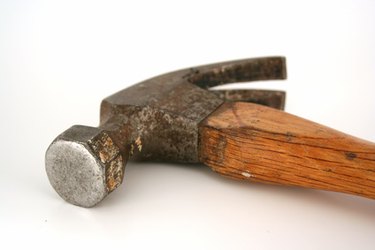
Carpenter can gather large collections of hand and power tools that vary with the type of carpentry they specialize in. After they acquire the basics, the specialist tools make them more productive and the work easier. A handful of tools have unfamiliar names, but the majority describe the operation they perform.
Striking Tools
Video of the Day
The claw hammer is a basic striking tool, named for the forked, curved end opposite the striking face of the tool that carpenters use to pull nails and perform other prying operations. They often keep a heavier sledge hammer nearby for wrestling bigger timbers or joists into place. Pneumatic nailers have replaced the hammer for production work such as framing and cabinet assembly.
Video of the Day
One of the most unique striking tools is a slide hammer. Its striking head slides on a rod for use in tight spaces where the carpenter cannot swing the hammer but slides the weight up or down, directly in line with the nail's head
Cutting Tools
Two hand saws complement one another in the toolbox. The rip saw has teeth filed to cut with the grain of the wood and a crosscut saw is designed to cleanly cut across the grain. Chisels are hand tools with one sharpened edge, used for chopping away wood for joinery purposes.
A circular saw, sometimes called a skil-saw, is the most common power tool that the carpenter will use. The second most common is the drill-driver, a tool that is equally adept at boring holes and driving screws. For rougher work such as demolition, the carpenter may also use a reciprocating saw with its plunging blade that can cut through nearly anything. Circular cuts or finer work find him reaching for the smaller saber saw.
Measuring Tools
The carpenter will not be without a tape measure, a coiled, flexible ruler. A carpenter’s square is an L-shaped flat metal device that determines the accuracy of 90 degree joinery. The edges of the square are also marked to lay out roof angles and the rise of a staircase. A speed square is a triangular tool, with which a carpenter verifies square and mark square lines for cutting with its lip.
Other Tools
The carpenter's most common tool carried is a utility knife with replaceable blades. Levels of various lengths contain vials filled with liquid and an air bubble which indicate when they are lying level. Along with the square, the level checks the overall quality of the carpenter’s work. The plumb bob and level are being supplanted in the early 21st century by laser tools with gyroscopic mechanisms. Mounted on a tripod or held to a wall, these tools project a laser line that extends beyond the reach of the longest levels and verifies the level of multiple walls at once.
Unusual Names
A brace is a hand-powered drill the carpenter uses where power is not available. It is rare in the era of cordless tools but can save the day when the battery dies. Trim carpenters often rely on smaller tools like the dozuki, a fine-tooth Japanese saw, to make tight joinery's precision cuts. The most confusing set of tool names is in the hand plane family with the jack plane, the smoothing plane, the block and shoulder planes. Each performs a unique task but you would never know it from their titles.